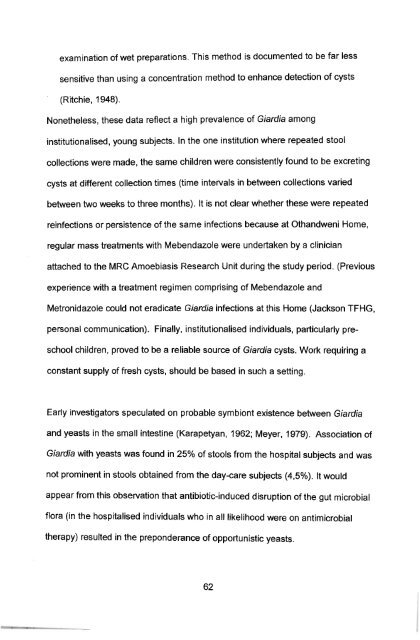in vitro culture and isoenzyme analysis of giardia lamblia
in vitro culture and isoenzyme analysis of giardia lamblia
in vitro culture and isoenzyme analysis of giardia lamblia
Create successful ePaper yourself
Turn your PDF publications into a flip-book with our unique Google optimized e-Paper software.
exam<strong>in</strong>ation <strong>of</strong> wet preparations. This method is documented to be far less<br />
sensitive than us<strong>in</strong>g a concentration method to enhance detection <strong>of</strong> cysts<br />
(Ritchie, 1948).<br />
Nonetheless, these data reflect a high prevalence <strong>of</strong> Giardia among<br />
<strong>in</strong>stitutionalised, young subjects. In the one <strong>in</strong>stitution where repeated stool<br />
collections were made, the same children were consistently found to be excret<strong>in</strong>g<br />
cysts at different collection times (time <strong>in</strong>tervals <strong>in</strong> between collections varied<br />
between two weeks to three months). It is not clear whether these were repeated<br />
re<strong>in</strong>fections or persistence <strong>of</strong> the same <strong>in</strong>fections because at Oth<strong>and</strong>weni Home,<br />
regular mass treatments with Mebendazole were undertaken by a cl<strong>in</strong>ician<br />
attached to the MRC Amoebiasis Research Unit dur<strong>in</strong>g the study period. (Previous<br />
experience with a treatment regimen compris<strong>in</strong>g <strong>of</strong> Mebendazole <strong>and</strong><br />
Metronidazole could not eradicate Giardia <strong>in</strong>fections at this Home (Jackson TFHG,<br />
personal communication). F<strong>in</strong>ally, <strong>in</strong>stitutionalised <strong>in</strong>dividuals, particularly preschool<br />
children, proved to be a reliable source <strong>of</strong> Giardia cysts. Work requir<strong>in</strong>g a<br />
constant supply <strong>of</strong> fresh cysts, should be based <strong>in</strong> such a sett<strong>in</strong>g.<br />
Early <strong>in</strong>vestigators speculated on probable symbiont existence between Giardia<br />
<strong>and</strong> yeasts <strong>in</strong> the small <strong>in</strong>test<strong>in</strong>e (Karapetyan, 1962; Meyer, 1979). Association <strong>of</strong><br />
Giardia with yeasts was found <strong>in</strong> 25% <strong>of</strong> stools from the hospital subjects <strong>and</strong> was<br />
not prom<strong>in</strong>ent <strong>in</strong> stools obta<strong>in</strong>ed from the day-care subjects (4,5%). It would<br />
appear from this observation that antibiotic-<strong>in</strong>duced disruption <strong>of</strong> the gut microbial<br />
flora (<strong>in</strong> the hospitalised <strong>in</strong>dividuals who <strong>in</strong> all likelihood were on antimicrobial<br />
therapy) resulted <strong>in</strong> the preponderance <strong>of</strong> opportunistic yeasts.<br />
62
















